Sponsored Content by Bio-TechneReviewed by Olivia FrostJan 8 2024
An organoid is a simplified and smaller version of an organ produced in vitro. Organoids resemble the cellular architecture and composition of the original tissue and demonstrate functional similarities. This article talks about enhancing organoid culture optimization and the importance of growth factor bioactivity and reagent consistency.
Organoids are derived from embryonic stem cells (ESCs), primary tissue, or induced pluripotent stem cells (iPSCs), which are capable of self-renewal and differentiation. In certain culture conditions, these cells will form three-dimensional structures that self-organize into organ-like tissues.
Organoids are comprised of various cell types arranged in precise alignment with each other and the extracellular matrix. These components exist within a physiologically appropriate environment. Organoids are also flexible to long-term expansion and manipulation and are therefore increasingly utilized as in vitro model systems for studying human organ development, drug efficacy or toxicity, modeling disease conditions, and investigating personalized medicine.
Organoid systems have been developed for various human tissues, including brain, kidney, lung, liver, pancreas, colon, inner ear, intestine, prostate, and retina. As the conditions for culturing organoids vary, the reagents and protocols required for their generation must be tested and optimized.
Once established, researchers must ensure that the optimal culture conditions are reproducible so that the organoids can be passaged successfully. This instills confidence, as researchers know that they are working with identical systems in successive experiments.
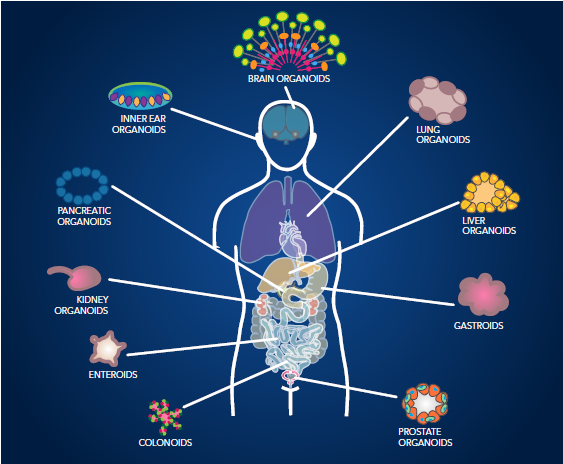
Image Credit: Bio-Techne
R&D Systems™ is the most trusted source of recombinant proteins for organoid research
Some of the more crucial components of organoid media are growth factors (like R-Spondins, Noggin, and Wnt-3a), which must display batch-to-batch consistency, high levels of activity, and be free of contaminants to guarantee that they provide consistent and optimal organoid growth.
These proteins can be challenging to make, so the reagents must be obtained or produced from a trusted source to ensure they maintain a high level of activity and consistency. This gives researchers the confidence that the experiments will be reproducible over time.
Many organoid researchers rely on R&D Systems as a reliable source of reagents because of its quality control specifications and rigorous in-house testing. This is substantiated by the multitude of publications referencing the utilization of R&D Systems R-Spondins, Noggin, or Wnt-3a proteins for culturing organoids.
R&D Systems’ recombinant human R-Spondin 1, Wnt-3a, and Noggin routinely display higher levels of bioactivity than competitors’ proteins, and every new lot is tested side-by-side with previous lots to confirm that the new lot exhibits the same level of bioactivity and purity as those before. New lots are also tested to ensure they meet expectations for industry-leading endotoxin specifications at <0.1 EU/μg.
With more than 30 years of experience manufacturing and purifying recombinant proteins, R&D Systems offers customers a stable source and the expertise needed to ensure that its growth factors offer superior performance and minimal variation lot-to-lot.
R&D Systems recombinant human R-Spondin 1, Wnt-3a, and Noggin display higher levels of activity than leading competitors’ proteins

R&D Systems Recombinant Human R-Spondin 1, Wnt-3a, and Noggin Display Higher Activity than the Same Proteins Provided by Leading Competitors. (A) The ability of R&D Systems Recombinant Human R-Spondin 1 (Catalog # 4645-RS; blue line) or recombinant human R-Spondin 1 from a leading competitor (red line) to stimulate activation of beta-Catenin using a TOPflash beta-Catenin/TCF reporter assay was tested in the HEK293T human kidney cell line, in the presence of Recombinant Mouse Wnt-3a (R&D Systems, Catalog # 1324-WN; 5 ng/mL). The ED50 for this effect for R&D Systems Recombinant Human R-Spondin 1 was approximately 7-fold greater than the competitor’s R-Spondin 1. We also offer highly active Recombinant Human R-Spondin 3 (R&D Systems, Catalog # 3500-RS), which is being increasingly used for culturing different types of organoids. (B) The bioactivity of R&D Systems Recombinant Human Wnt-3a (Catalog # 5036-WN; orange line) or human Wnt-3a from another company (blue line) was assessed by measuring the ability of the proteins to induce alkaline phosphatase production in the MC3T3-E1 mouse preosteoblast cell line. The ED50 for this effect of R&D Systems Recombinant Human Wnt-3a was 1.7-fold better, with more than twice the maximum response compared to the competitor’s Wnt-3a. (C) The bioactivity of R&D Systems Recombinant Human Noggin (Catalog # 6057-NG; orange line) or recombinant human noggin from a top competitor (blue line) was assessed by measuring the ability of the proteins to inhibit alkaline phosphatase production induced by 50 ng/mL Recombinant Human BMP-4 (Catalog # 314-BP) in the ATDC5 mouse chondrogenic cell line. The ED50 for this effect for R&D Systems Recombinant Human Noggin in the presence of 50 ng/mL of Recombinant Human BMP-4 was approximately 30-fold greater than the top competitor’s Noggin. Image Credit: Bio-Techne
R&D Systems recombinant human R-Spondins, Wnt-3a, and Noggin display high lot-to-lot consistency to support optimized, reproducible organoid growth

Lot-to-Lot Consistency Testing of R&D Systems Recombinant Human R-Spondin 1, R-Spondin 3, and Wnt-3a Proteins. Three independent lots of (A) Recombinant Human R-Spondin 1 (R&D Systems, Catalog # 4645-RS), or (B) Recombinant Human R-Spondin 3 (R&D Systems, Catalog # 3500-RS) were tested for their ability to stimulate activation of beta-Catenin using a TOPflash beta-Catenin/TCF reporter assay in the HEK293T human kidney cell line, in the presence of 5 ng/mL Recombinant Mouse Wnt-3a (R&D Systems, Catalog # 1324-WN). Each trace shown on the graph represents data obtained from Recombinant Human R-Spondin 1 or Recombinant Human R-Spondin 3 from a different manufacturing run. (C) Three independent lots of Recombinant Human Wnt-3a (R&D Systems, Catalog # 5036-WN) were tested for their ability to induce alkaline phosphatase production in the MC3T3-E1 mouse preosteoblast cell line. Each trace shown on the graph represents data obtained from Recombinant Human Wnt-3a from a different manufacturing run, demonstrating the lot-to-lot consistency of the protein. Image Credit: Bio-Techne

Lot-to-Lot Consistency Testing of Recombinant Human Noggin Demonstrates that R&D Systems Noggin Protein Displays Minimal Lot-to-Lot Variability and Higher Activity than Two Leading Competitors’ Noggin Proteins. (A) Three independent lots of Recombinant Human Noggin (R&D Systems, Catalog # 6057-NG) were tested for their ability to inhibit alkaline phosphatase production induced by 50 ng/mL Recombinant Human BMP-4 (R&D Systems, Catalog # 314-BP) in the ATDC5 mouse chondrogenic cell line. Each trace shown on the graph (orange, light blue, purple) represents data obtained from Recombinant Human Noggin from a different manufacturing run. The blue trace on the graph shows the ability of Recombinant Human BMP-4 (50 ng/mL) to induce alkaline phosphatase production. (B) BG01V human embryonic stem cells were cultured in Mouse Embryonic Fibroblast Conditioned Media (R&D Systems, Catalog # AR005) supplemented with FGF basic (5 ng/mL). Stem cells were driven into early cells of the neuroectoderm using a 3-day incubation in Recombinant Human Noggin (25 µg/mL) from either R&D Systems (Lot 1, Lot 2; Catalog # 6057-NG) or from two separate competitors (Competitor 1, Competitor 2). Control cells were not incubated in Noggin (No Noggin). (Left) Representative images of embryonic stem cells that were stained for the early ectoderm marker, Otx2 (red), the neuroectoderm marker, SOX1 (green), and DAPI (blue), following differentiation with Noggin from R&D Systems or Noggin from Competitor 2. (Right) Quantification of SOX1+ clusters under each of the indicated culture conditions. Cells treated with R&D Systems Noggin showed an increase in SOX1+ cells compared to both untreated and competitor-treated cells. R&D Systems Noggin also showed consistent differentiation across the lots tested. BG01V human embryonic stem cells are licensed from ViaCyte, Inc. Image Credit: Bio-Techne
Bio-Techne offers a complete portfolio of reagents designed to promote the robust, reproducible expansion of organoids
As well as R&D Systems’ recombinant proteins, Bio-Techne also has a range of products that are tested and designed for superior performance and consistency throughout the expansion, culture, and passaging of organoids. These include various formats of organoid-qualified Cultrex™ Basement Membrane Extract (BME), N-2 MAX and N-21 MAX media supplements, Cultrex Organoid Harvesting Solution, media, extracellular matrix proteins, and small molecules often utilized in organoid cultures.
Cultrex™ UltiMatrix reduced growth factor basement membrane extract
Several different formats of Cultrex Basement Membrane Extract (BME) can be provided for two-dimensional and three-dimensional (3D) cell cultures. Cultrex UltiMatrix Reduced Growth Factor (RGF) BME is a soluble form of basement membrane matrix hydrogel that offers enhanced levels of entactin, elevated protein concentration, high tensile strength, and robust purity and clarity. These compositional improvements result in substantial performance benefits, making Cultrex UltiMatrix RGF BME an ideal extracellular matrix for consistent organoid and stem cell culture.
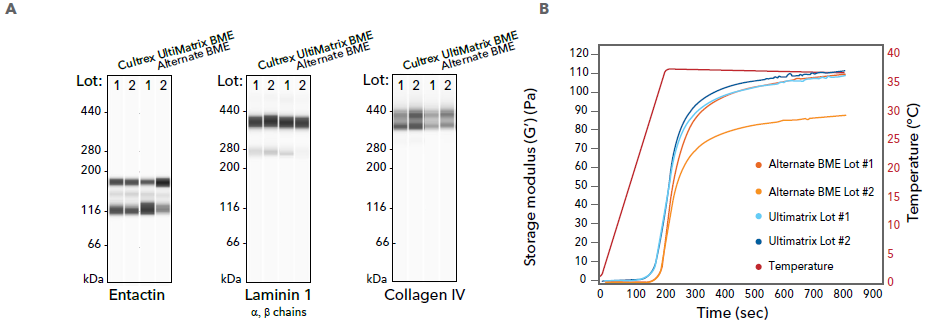
Cultrex UltiMatrix RGF Basement Membrane Extract (BME) Displays Consistent Lot-to-Lot ECM Composition, High Tensile Strength, and Gel Rates. (A) Simple Western analysis for Entactin, Laminin, and Collagen IV across two lots of both Cultrex UltiMatrix RGF BME (R&D Systems, Catalog # BME001-05) and an alternate commercial BME matrix. Cultrex UltiMatrix RGF BME shows consistent expression of Entactin, compared to the alternate ECM matrix. (B) Analysis of the tensile strength (elastic modulus) dynamics across two lots of Cultrex UltiMatrix RGF BME (R&D Systems, Catalog # BME001-05) and an alternate commercial BME matrix. The elastic modulus was measured at increasing temperatures to determine tensile strength and gelling rate across two independent lots of Cultrex UltiMatrix RGF BME and the alternate BME matrix. Cultrex UltiMatrix RGF BME was found to display consistent gelling rates and high tensile strength (storage modulus) compared to the alternate commercial BME matrix. Image Credit: Bio-Techne

Human Descending Colon Organoids Grown in Cultrex UltiMatrix RGF Basement Membrane Extract. Adult stem cells isolated from human descending colon were embedded in Cultrex UltiMatrix RGF BME (R&D Systems, Catalog # BME001-05) and cultured in growth medium for 30 days before imaging. (A) Brightfield image of descending colon organoid showing tissue invagination and epithelial layer formation. (B, C) Descending colon organoids were stained with an Anti-Human Chromogranin A Monoclonal Antibody (green; R&D Systems, Catalog # MAB90981), to visualize intestinal enteroendocrine cells, and counterstained with an Anti-Human/Mouse E-Cadherin Antigen Affinity-purified Polyclonal Antibody (red; R&D Systems, Catalog # AF748) and DAPI (blue; Tocris Bioscience, Catalog # 5748). Image Credit: Bio-Techne
Serum-free media supplements
To support organoid cultures, N-2 MAX and N21-MAX media supplements are also available. The N21-MAX Media Supplement improves upon the conventional B27- and NS21-like supplements, which are becoming increasingly popular for stem cell optimization and 3D cell culture media.
Both media supplements are serum-free, fully defined supplements designed to remove uncontrolled variables, like those found in serum-containing media and commercial serum-free supplements.
Using these media supplements reduces unwanted experimental variations and has proven to improve the differentiation of stem cells while increasing the health and viability of differentiated cell types throughout long-term cell culture conditions.

Lot-to-Lot Consistency Testing of N-2 MAX Media Supplement. Rat cortical stem cells (RCSC) were cultured over multiple passages using N-2 MAX (R&D Systems, Catalog # AR009) and evaluated via flow cytometry for the maintenance of the stem cell markers, SOX2 and Nestin. Quantification of flow cytometry data demonstrates a high purity of (A) SOX2 or (B) Nestin positive RCSCs across multiple lots of N-2 MAX Supplement. (C) Average SOX2 and Nestin-positive RCSCs, demonstrate the consistent lot-to-lot performance of N-2 MAX. Image Credit: Bio-Techne
Small molecules for culturing organoids
Bio-Techne provides a large range of Tocris™ small molecules which are often used as 3D growth matrix components to generate different types of organoids and sustain long-term growth. Included in these products are A 83-01, N-acetylcysteine, dexamethasone, Gastrin I, CHIR 99021, DAPT, nicotinamide, SB 202190, and others.
Cryopreservation media
Protein-free cryopreservation media for cryopreservation of stem cells or optimized cryopreservation of cell lines are additionally available. These media are specially formulated and contain a defined serum substitute. They also include an optimized concentration of a cryopreservative, which improves the viability and recovery of healthy cells compared to traditional freezing media.
Cultrex Organoid Harvesting Solution
Bio-Techne’s catalog also contains Cultrex Organoid Harvesting Solution, which offers a non-enzymatic method for depolymerizing extracellular matrix proteins, which allows intact organoids to be harvested for passaging, biochemical analysis, or cryopreservation.
Anti-bodies and RNAscope™ in situ
As well as a portfolio of reagents for organoid culture, Bio-Techne provides an impressive selection of antibodies from the R&D Systems™ and Novus Biologicals™ brands for detecting lineage-specific markers. Bio-Techne also offers RNAscopeTM in situ hybridization assays, which identify specific target RNAs in intact cells when suitable antibodies are not available.
R&D systems scientists are developing organoid culture protocols and other organoid-related resources to assist researchers
To support researchers focused on generating organoids as model systems, R&D Systems is diligently working to optimize the culture conditions for growing various types of organoids.
R&D Systems are publishing the reagents utilized, as well as the recipes and protocols in its
Organoid Resource web page—which can be accessed easily by researchers interested in using organoids as model systems.
For instance, the materials required to culture human liver or lung organoids are detailed below with links to the in-house protocols. The Organoid Resources page contains additional information, including organoid-related webinars, blogs, scientific posters, and literature.
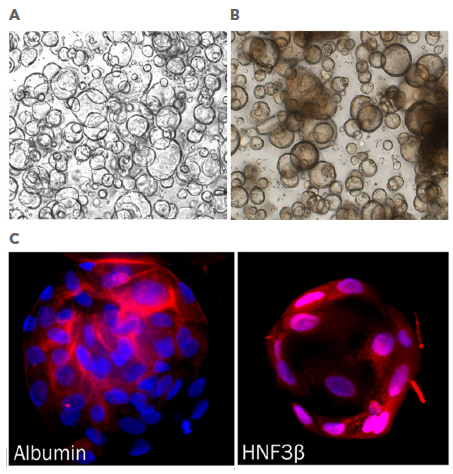
Undifferentiated and Differentiated Human Liver Organoids. Representative brightfield images of human (A) undifferentiated and (B) differentiated liver organoids that were cultured using Cultrex UltiMatrix RGF Basement Membrane Extract (R&D Systems, Catalog # BME001-05) and the Bio-Techne reagents listed in the Materials table shown for culturing human liver organoids. The organoids were differentiated in media containing Recombinant Human FGF-19 (R&D Systems, Catalog # 969-FG), DAPT (Tocris Bioscience, Catalog # 2634), and Dexamethasone (Tocris Bioscience, Catalog # 1126). C) Undifferentiated liver organoids shrink as they differentiate and have positive expression of the hepatocyte markers, Albumin (C, left) and HNF-3beta (C, right), which were detected using a Mouse Anti-Human Serum Albumin Monoclonal Antibody (left, red; R&D Systems, Catalog # MAB1455) and a Goat Anti-Human HNF-3beta Antigen Affinitypurified Polyclonal Antibody (right, red; R&D Systems, Catalog # AF2400), respectively. DAPI (Tocris Bioscience, Catalog # 5748) was used as a counterstain in part C of the figure (blue). Image Credit: Bio-Techne
Culturing human liver organoids
Table 1. Materials needed for human liver organoid culture. Source: Bio-Techne
| Reagent Name |
Supplier |
Catalog # |
| Cultrex Organoid Harvesting Solution |
R&D Systems |
3700-100-01 |
Cultrex UltiMatrix Reduced Growth
Factor Basement Membrane Extract |
R&D Systems |
BME001-05 |
| GlutaminePlus |
R&D Systems |
B90210 |
| HEPES |
Tocris |
3173 |
| Advanced DMEM/F-12 Cell Culture Medium |
Thermo Fisher |
12634-010 |
| N21-MAX Supplement |
R&D Systems |
AR008 |
| N-2 MAX Supplement |
R&D Systems |
AR009 |
| N-Acetylcysteine |
Tocris |
5619 |
| Gastrin I (Human) |
Tocris |
3006 |
| Nicotinamide |
Tocris |
4106 |
| Y-27632 (ROCK inhibitor) |
Tocris |
1254 |
| Recombinant Human EGF |
R&D Systems |
236-EG |
| Recombinant Human R-Spondin 1 |
R&D Systems |
4645-RS |
| Recombinant Human Noggin |
R&D Systems |
6057-NG |
| Recombinant Human FGF-10 |
R&D Systems |
345-FG |
| Recombinant Human FGF-19 |
R&D Systems |
969-FG |
| Recombinant Human BMP7 |
R&D Systems |
354-BP |
| Recombinant Human HGF |
R&D Systems |
294-HG |
| Recombinant Human Wnt-3a |
R&D Systems |
5036-WN |
| Forskolin |
Tocris |
1099 |
| A 83-01 (ALK5 inhibitor) |
Tocris |
2939 |
| DAPT |
Tocris |
2634 |
| Dexamethasone |
Tocris |
1126 |
Culturing human lung organoids
Table 2. Materials needed for human lung organoid culture. Source: Bio-Techne
| Reagent Name |
Supplier |
Catalog # |
| Cultrex Organoid Harvesting Solution |
R&D Systems |
3700-100-01 |
Cultrex UltiMatrix Reduced Growth
Factor Basement Membrane Extract |
R&D Systems |
BME001-05 |
| GlutaminePlus |
R&D Systems |
B90210 |
| HEPES |
Tocris |
3173 |
| Advanced DMEM/F-12 Cell Culture Medium |
Thermo Fisher |
12634-010 |
| N21-MAX Supplement |
R&D Systems |
AR008 |
| N-Acetylcysteine |
Tocris |
5619 |
| Penicillin/Streptomycin |
R&D Systems |
B21210 |
| A 83-01 (ALK5 inhibitor) |
Tocris |
2939 |
| SB 202190 (p38 MAPK inhibitor) |
Tocris |
1264 |
| Nicotinamide |
Tocris |
4106 |
| Y-27632 (ROCK inhibitor) |
Tocris |
1254 |
| Recombinant Human R-Spondin 1 |
R&D Systems |
4645-RS |
| Recombinant Human Noggin |
R&D Systems |
6057-NG |
| Recombinant Human FGF-10 |
R&D Systems |
345-FG |
| Recombinant Human FGF-7 |
R&D Systems |
251-KG |
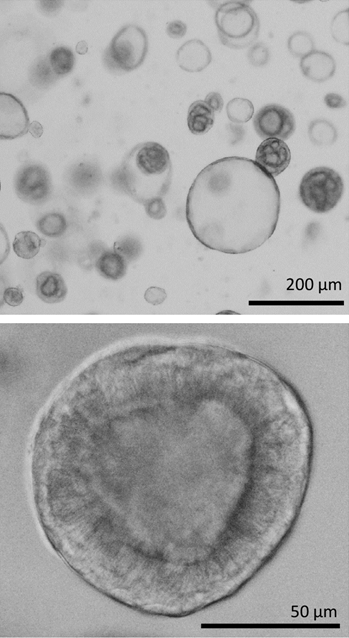
Human Lung Organoids Grown in Cultrex UltiMatrix RGF Basement Membrane Extract (BME). Representative images of lung organoids, derived from lung biopsy adult stem cells, embedded in Cultrex UltiMatrix RGF BME (R&D Systems, Catalog # BME001-05) and cultured in Lung Organoid Expansion Media. Images show organoids at day 52 of culture. Image Credit: Bio-Techne

Characterization of Human Lung Organoids. Representative images of human lung organoids stained for tissue-specific cell types. (A) Expression of SOX2 (green) and Acetylated Tubulin (red) was assessed using an Anti-Human/Mouse/Rat SOX2 Antigen Affinity-purified Polyclonal Antibody (R&D Systems, Catalog # AF2018) and an Anti-Acetylated Tubulin Monoclonal Antibody, respectively. (B) Expression of p63/TP73L (green) and Cytokeratin 10 (red) was assessed using an Anti-Human p63/TP73L Antigen Affinity-purified Polyclonal Antibody (R&D Systems, Catalog # AF1916) and an Anti-Cytokeratin 10 Monoclonal Antibody (Novus Biologicals, Catalog # NBP2-61736), respectively. (C) Expression of Podoplanin (green), a marker of type 1 alveolar cells, was assessed using an Anti-Human Podoplanin Antigen Affinity-purified Polyclonal Antibody (R&D Systems, Catalog # AF3670). Image Credit: Bio-Techne
About Bio-Techne
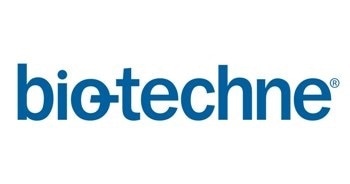
Bio-Techne Corporation is a leading developer and manufacturer of high-quality purified proteins - notably cytokines and growth factors, antibodies, immunoassays, as well as biologically active small molecule compounds - which are sold to biomedical researchers and clinical research laboratories; these operations constitute the core Biotech Division, headquartered in Minneapolis, Minnesota.
The Protein Platform Division manufactures innovative protein analysis tools under the ProteinSimple brand name that greatly automate western blotting and immunoassay practices. The Diagnostics Division manufactures FDA-regulated controls, calibrators, blood gas, and clinical chemistry controls for OEM customers and clinical customers. Bio-Techne products assist scientific investigations into biological processes and the nature and progress of specific diseases. They aid in drug discovery efforts and provide the means for accurate clinical tests and diagnoses.
With thousands of products in its portfolio, Bio-Techne generated approximately $563 million in net sales in fiscal 2017 and has approximately 1,800 employees worldwide.
Sponsored Content Policy: News-Medical.net publishes articles and related content that may be derived from sources where we have existing commercial relationships, provided such content adds value to the core editorial ethos of News-Medical.Net which is to educate and inform site visitors interested in medical research, science, medical devices and treatments.